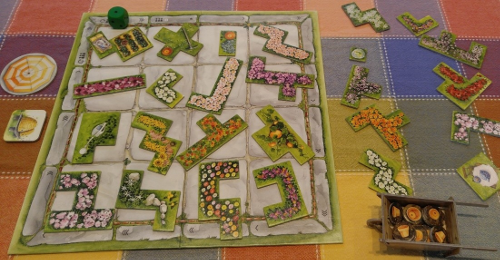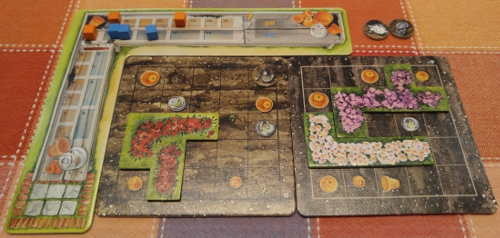Cottage Garden Review
on Aug 2, 2017
Rosenberg’s big box design A Feast for Odin is a Zeus of a game and not just because of its size. From it sprung two games based on its tile placement mechanic. The first, Patchwork, was released in 2014 and got more “best game to play with my significant other†recommendations than the board game internet could handle. Cottage Garden is the second release, which I was really pumped for after the other two games. Unfortunately, Cottage Garden isn’t the continuation of polyomino goodness I was hoping for.
The tiles in Cottage Garden are housed on a central board. Each turn, you may select one of the tiles in the row under the Gardener (i.e., a large green die that marks the current round). Placing tiles on your board is straightforward. Not having overlapping tiles or edges hanging off the board is intuitive for most players, which makes explaining the crux of the game fairly easy. Where things get a little more nuanced to explain is the score tracks. Each player’s board has an orange and blue score track for the points they receive from the number of pots or cloches, respectively, when one or both of their flowerbeds is completed. What makes this scoring a bit odd is that you have three cubes for each track. There is supposed to be some decision-making in which cube to push up the track, but the incentives aren’t all that enticing. When passing the red line halfway up the track, you receive a cat. Though useful to fill an awkward open space in your flowerbed or to add more tiles to the row before choosing a tile, receiving a cat in the game is about as exciting trying to teach a real cat to play fetch. Additionally, in an attempt to compel players to race to finish their flowerbeds, the first person to reach the uncreatively named “target space†at the end of the track receives a beehive bonus token, worth two points at the end of the game (or one if you’re the second person to land on your target space).

The superfluously adorable wheelbarrow is one of the best parts of the game.
As mentioned above, Cottage Garden gives you two boards to play tiles. If you double the flowerbed, you double the fun, right? Not exactly. When you choose a tile from the Gardner’s Row, you also can place it in either flowerbed. In theory, this provides you with more choices since each board has a different number of pots and cloches for you to position your tiles around. In practice, it makes the tile placement anticlimactic. Instead of stressfully contemplating how to best arrange your pieces, you usually just select whatever is available to you with minimal thought, and place it on your flowerbed with the same apathy I have when weeding my actual yard. The tiles are fairly consistently shaped. There aren’t any wild and crazy ninja star-looking pieces that you proudly squeeze into the perfect spot. Everything will pretty much fit, usually without too much thought or having to cover up those pots or cloches. Even when you do have a leftover space or two, you can easily fill it in with a pot tile or cat. It’s like doing paint-by-numbers where you decide to go crazy and use red instead of blue, but it’s still going to be the same picture in the end. Completing a flowerbed is more a matter of time than slick spatial skills.

Not sure how to finish off that flowerbed? Try a cat.
You continue this process of selecting tiles and churning out flowerbeds after flowerbed for five rounds. The generally quick turns – thanks to the limited tile selection – screech to a halt when players fill a flowerbed and have to clear their boards, restock tiles, and grab a new board. The only upside to this pausing every few turns for fiddly housekeeping is that it breaks up the monotonous pacing. Then, in the sixth round, the game bizarrely starts to devolve. Before your turn occurs as normal, you lose two points from either track of your choice. In a game that up to this point has been rather toothless and mundane, the sudden shift to a punitive change in the rules is jarring and unpleasant.
It’s hard not to compare Cottage Garden against its charming older sibling Patchwork. The latter game is a fantastic design deserving of all the praise it has received. I admit that part of my disappointment with Cottage Garden is because it is overshadowed by Patchwork. However, I’m not convinced that had Cottage Garden been released first, we would be singing its praises instead. The appeal of Cottage Garden is that it can play more than two. However, the game falls short there as well considering the classic Reiner Knizia Tetris game FITS and the new Phil Walker-Harding title, Bärenpark, are both handedly superior. Cottage Garden’s main redeeming quality is that it is a relatively simple and genteel design. Still, this isn’t enough to keep it from get buried under Rosenberg’s many other more standout designs.

 Customer Support
Customer Support  Subscribe
Subscribe 




 Account
Account  Wishlist
Wishlist 

